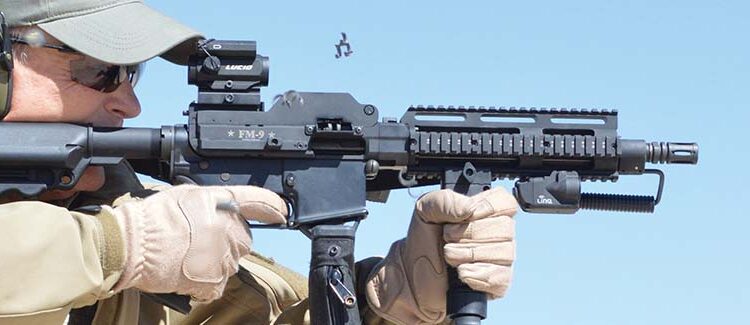By Chris A. Choat
If you are a long time gun enthusiast, as this author is, you have probably owned a virtual gamut of various types and calibers of firearms. I started out owning a .22 rifle, followed by bolt-action centerfire rifles, progressing through all sorts of semi-auto handguns and rifles, then moving on into the Class III realm of submachine guns and heavy machine guns. It seems like the pinnacle of firearms ownership is a full-auto firearm and then on past that is a belt-fed full-auto. In years past if you owned a select-fire weapon whether it be magazine or belt-fed, if you could afford the gun, the price of ammunition needed to feed it should be no problem. At today’s ammunition prices feeding “the beast” is a very expensive proposition. This has made owning a belt-fed gun (either semi or select-fire) out of the range of most shooters. Things have now changed dramatically with the introduction of a new accessory for the AR-15/M-16 series of weapons called the FM-9 from Freedom Ordnance.
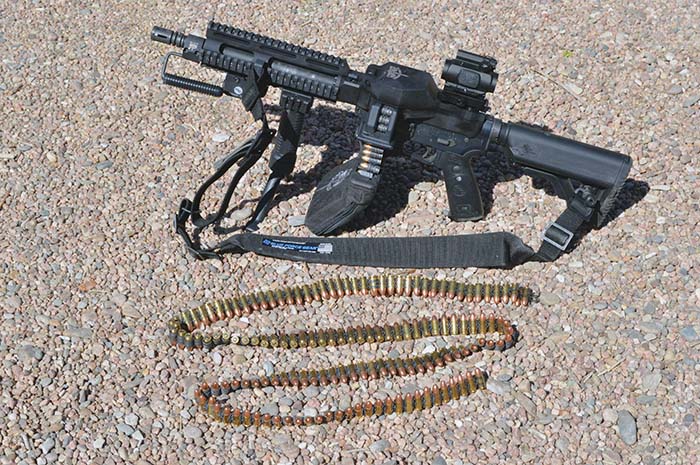
The FM-9 is a complete upper receiver unit that drops right onto either a semi-auto AR-15 or a select-fire M-16 series rifle lower receiver. The unit comes complete with everything you need to change either one of these guns into a belt-fed!! It also allows the shooter to be able to actually go out and shoot it regularly without breaking the bank because this new unit is chambered in 9mm! That’s right. It is a drop-in, no gunsmithing unit that allows your mil-spec AR or M-16 to fire disintegrating metal-linked 9x19mm ammunition. With some 9mm ammunition priced at or slightly below the $200.00 per 1000 round price, this is a unit that you can afford to go have fun with. Not only that, the entire unit sells for about the price of a high quality AR style gun. More on that later.
The Freedom Ordnance FM-9 started life as an idea, a 3-D printer and a Tormach CNC Milling machine. Within a few months the designers had some handmade links and the first 3 shots were fired in one of their backyards. Once the initial concept was proven they acquired a 10,000 square foot building to turn into their production facility. Production milling machines, lathes and other machines were ordered and were received and set in place in February of 2015. The design team then worked over 80 hours a week from February to the first of September of 2015 working out any bugs and making sure that they had a product that was perfectly reliable. They also wanted a product that would feed the most popular (and inexpensive) brands of 9mm 115 grain ammunition being produced. They started out testing many brands and ended up finding out that Tula steel case, PMC and Winchester White Box ammunition worked the best and surprisingly were the most inexpensive. The project was kept very tight-lipped until the end of August 2015 when they released a 15 second video teaser on YouTube. The video made the rounds on the popular internet forums where some claimed that it was vaporware or that it might be in production in “a few years”. The company set up a website with a pre-order page accepting orders, but no advance money, and 4 weeks later the first units were shipping. And the rest is, as they say, history. This author respects a company that does business this way instead of accepting money and then taking maybe years to get a new product into production.
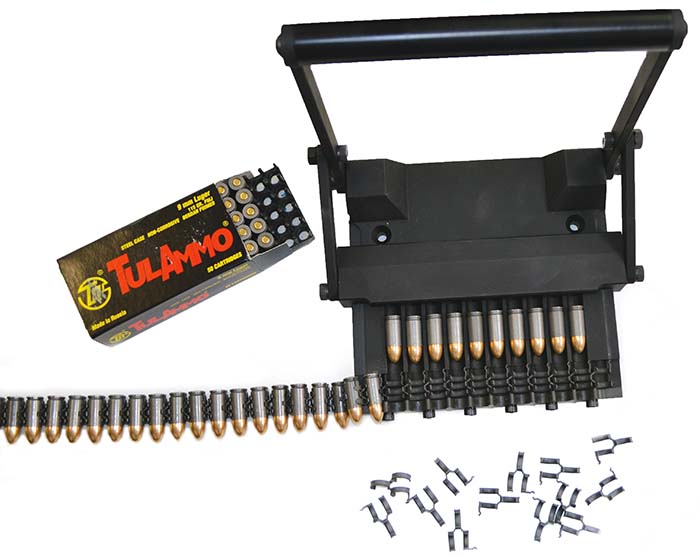
As stated before the FM-9 is a complete upper unit. The unit contains the upper receiver and belt feed mechanism, bolt assembly, feed chute, top cover and barrel extension along with the barrel and quad-rail forearm. The unit’s top cover is hinged at the front with a release latch at its rear. This allows it to hinge up and forward just like most other belt-feds. The top cover has a short 6-slot length of Picatinny on its top rear that allows for optic mounting. The forearm also has Picatinny rails at the 3, 6, 9 and 12 o’clock positions. The quad rail’s top rail is extended in height so that it co-witnesses with the rail mounted to the top cover. The rails are all laser engraved with positioning numbers.
The unit’s barrel is entirely free floated and is held into the barrel extension with a quick attach mechanism. The FM-9’s barrel can be quickly removed by the mere push of a release lever just in front of the top cover hinge. You just push the release lever and rotate the barrel about 1/4 turn with its attached handle and pull it forward out of the upper receiver. This works perfectly for changing out a hot barrel or changing out the barrel for one of a different length. Barrels are available in either 11 or 16.5 inches. There is also now a complete pistol upper which features a 6 inch barrel and a shortened quad rail. The unit that I tested came equipped with an 11 inch barrel as I intended on testing it on a select-fire post sample M-16 lower receiver. If you are going to use this size barrel on your semi-auto lower be sure to register the lower as an SBR first.
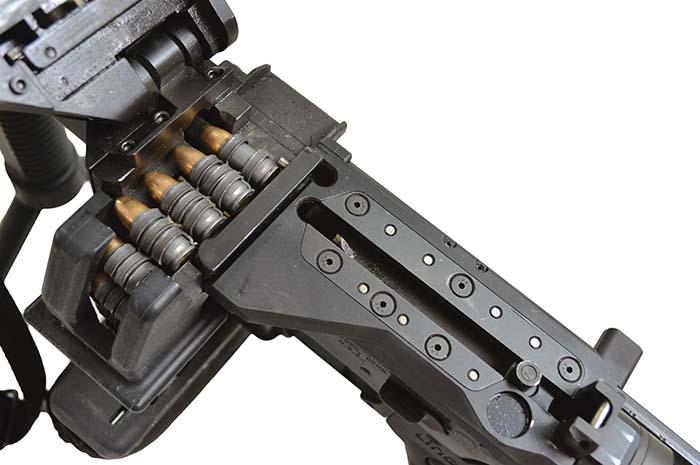
The FM-9 uses a proprietary bolt and carrier. The unit’s bolt carrier interfaces with the lower receiver’s existing 5.56 buffer and recoil spring without having to swap them out. The rear of the bolt carrier is hollow much the same as a 5.56 bolt carrier but it contains a removable weight. This weight can be installed or removed as needed to tailor the upper to the ammo used. For instance, if you are using hotter ammunition you can leave the weight in to limit cyclic rate as well as eliminating advanced wear in internal parts. The included owner’s manual tells the procedure for doing this based on the ejection pattern of empty brass thrown from the unit. Being able to use everything in your existing lower without having to swap out any parts is a great added feature. The bolt will work in either semi or select-fire guns.
The only other part that is needed to complete the conversion is a block that is inserted into the lower receiver’s magazine well. This block comes with the kit and is inserted from the top of the receiver and locks into place with the lower’s magazine release. Being inserted from the top, this block cannot be accidently dropped out if the shooter hits the magazine release button. This block also houses the ejector. The block also is used to attach a belt bag onto the completed gun. This block as well as a 150 round belt bag and 150 links also come with the unit. The included black Cordura bag holds 150 rounds of linked ammunition and has a zipper along its bottom to allow for easy insertion of a loaded belt. The top part of the bag is riveted onto an aluminum block that features a mating dovetail attachment that locks into the magazine well block. A spring loaded ball detent holds the two blocks firmly together but allows for instant removal of an empty bag and insertion of a loaded bag. The finish on the entire upper, barrel and belt bag attachment block is a hard anodized matte black that matches the finish on almost all of today’s AR style black rifles.
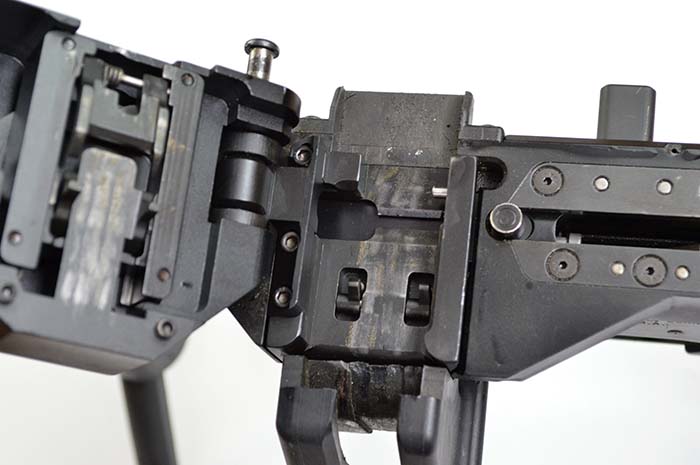
We started the T&E test by naturally having to load ammunition into the links to make the belts. As stated before, the FM-9 is fed with disintegrating metal spring steel links. The links are truly a marvel. Remember you are dealing with a straight walled cartridge case, not a tapered or bottlenecked case like most other belt-fed guns use. The links for the FM-9 are made especially for it. They are not existing links that have been modified to work with this unit. The manufacturers told me that designing and manufacturing the links was almost as big a challenge as building the upper itself. The links are spring steel, parkerized and have a tab that locks into the rim of the 9mm cartridge. I proceeded to load 100 rounds of steel cased Tula 115 grain FMJ ammunition into 2-50 round belts. This was done by hand which can be accomplished, but loading the two belts took me almost 30 minutes. Not only that, both of my thumbs were still sore two days later. I remembered that a friend of mine had e-mailed me a press release about a new product that had just been introduced. It was a belt linker made just for the FM-9. A call to Shepard Bruner at www.triggerjockey.com and one of his Belt Loaders was on its way to me. The loaders that he makes are precision made units machined on CNC equipment. With his loader you can load 10 cartridges into links in about 30 seconds. You merely lay 10 links onto the linker, put 10 rounds of ammunition into milled slots and pull the handle. Do this 5 times and you have a 50-round belt and no sore thumbs.
With a supply of loaded belts I headed to the range. According to the manual that comes with the FM-9, loading the unit is a little different than loading most belt-feds. The manual states that you should load the upper with the top cover closed. It says to lock the bolt open and insert a belt up through the feed chute. Push the loaded belt up until you feel it lock over the belt retaining pawls and seat firmly against the cartridge stop. Give it a gentle pull to ensure that it is locked into place. When you are ready to fire, hit the bolt release or pull and release the charging handle to make the gun ready to fire. The FM-9 unit fires from the closed bolt position.
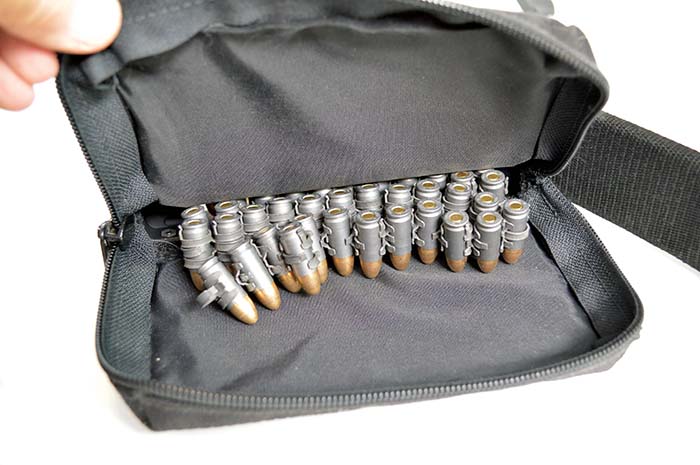
The upper was installed on a Colt M-16 post-sample lower receiver. The unit fit the lower perfectly with no rattle or play. I started out with the gun on semi-auto and proceeded to fire a few rounds. After about five rounds the gun stopped just as the bolt was pushing a round out of the belt. The top cover was opened, the gun cleared and we started to shoot again this time on full-auto. At about 10 rounds the gun stopped again with the same malfunction as before; a round just partially pushed out of the belt. The gun was cleared and this time a few drops of lube was put on the feed mechanism as well as the bolt. The gun then ran the rest of the belt with no issues what so ever. Not only that, it continued to run several more belts without any malfunctions. The upper unit was shipped to me without lubrication and that coupled with the fact that the links were all brand new must have attributed to the stoppages. The FM-9 unit has, to this date, continued to run perfectly with no malfunctions as long as the recommended ammunition was used. During the testing the ammunition used was Tula 115 grain FMJ and PMC 124 grain FMJ. They both ran without issues but we fired a lot more of the Tula as it was cheaper and more readily available. With Tula ammunition the unit ran like a sewing machine. The cyclic rate was checked with a PACT timer with rate-of-fire option and it averaged 820 rounds per minute as did just about all ammunition that was fired. With a cyclic rate like this and very low recoil you can literally write your name on the target.
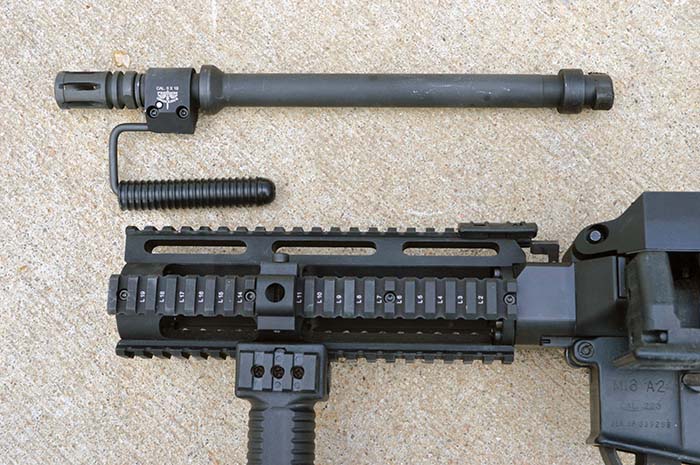
I did fire the gun with some of my own 147 grain hollow point reloads. I installed a Thompson Machine suppressor for use with this ammo as it was a subsonic load. As long as velocities were kept in the 1000 to 1050 feet-per-second range the ammunition ran fine and was very quiet. The FM-9 is amazing with a suppressor attached and using subsonic ammunition. You can literally hear the bullets hitting the target as well as the empty brass and links hitting the ground. Empty brass is thrown from the unit at the 3 o’clock position about 6 to 8 feet from the ejection port and the links land about half that far from the gun. The links land in a small pile for easy collection but we always managed to lose a few. This wasn’t considered a big deal as links are only $59.95 per 1000 directly from Freedom Ordnance. The company originally said that the links had a lifespan of about 8 loading and firing cycles but now they have refined their heat treating process and the links now have an almost infinite lifespan. Depending on where you shoot you will probably lose the links before you wear them out. (Just as this article was going to press the author received a new brass catcher from Tactical Brass Recovery for testing. This catcher attaches to the host gun with an American Defense quick attach lever mount that fastens to the right side rail on the quad forearm. The lever is incorporated into a spring loaded, hinge mechanism that allows the entire catcher to pivot out away from the gun to access the charging handle or to clear a malfunction. It has a rigid frame made from lightweight polymer as well as a top pate with holes to see inside. It features a black Cordura catch bag with a zippered bottom for easy emptying and will hold well over 150 brass and links. This unit is extremely well made and never missed catching a piece of brass or a link in over 500 rounds of testing.)
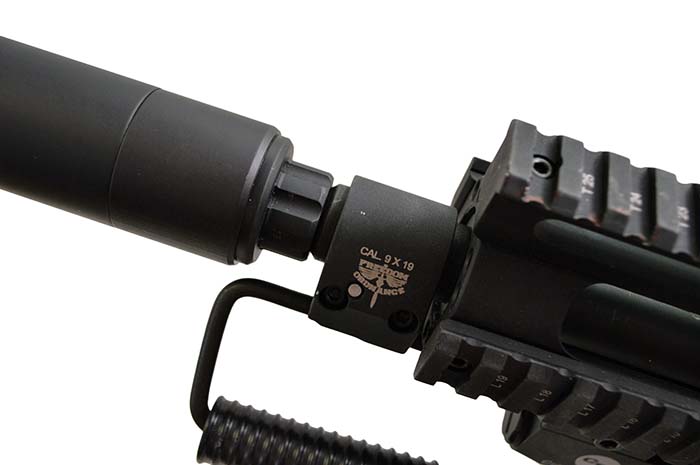
The author mounted a Lucid M-7 Micro red dot sight to the Picatinny rail on the top cover as the FM-9 comes without sights. This little sight is just right for the FM-9. It automatically varies its intensity according to ambient light but can also be user adjusted for 7 levels of dot intensity. It also features an automatic shut down to prevent draining the battery from leaving the sight on. It will run for literally thousands of hours on a single AAA battery. The sight features a 2 MOA dot, is recoil proof (up to .458 SOCOM) and waterproof down to 80 feet. All this in a sight that retails for under $200.00.
The author also got to try out a pre-production model of Crimson Trace’s new LiNQ™ sighting system. The LiNQ consists of an AR pistol grip and a combination light and green laser module that communicates wirelessly. This allows the laser/light module to be placed anywhere on the weapon and be activated by pushing an instinctive activation button mounted in the front of the grip. This is done wirelessly without having to have cables or wires running anywhere on the weapon. There is nothing to catch on or get tangled up with. The LiNQ has 4 modes; light only, laser only, light and laser or laser with strobing light. The unit has a master on/off switch mounted on the side of the grip. It operates on a unique closed wireless system with each unit having an individual wireless signature. That way several operators can use LiNQ mounted weapons without interference from other LiNQ units. The laser is a very intense green that can be seen even in daylight. The white light in the new unit is a very powerful 300 lumens which will light up objects well over 100 yards at night. The unit runs continuously for over 2 hours on two CR2 batteries (one in the grip and one in the light module). The LiNQ gives the user point and shoot capability in any light.
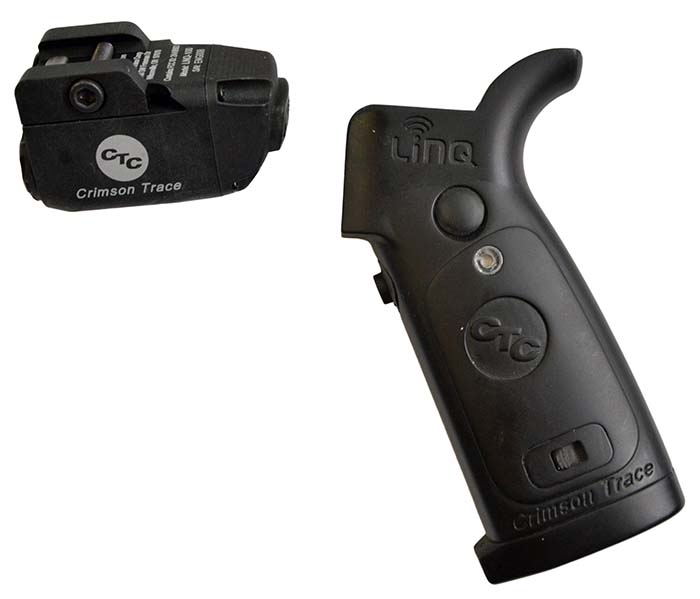
Accuracy from the FM-9 unit was truly amazing. It was sighted in at 50 yards and shot from a shooting bench. Once the optic and the laser were dialed-in the upper would group under an inch on semi-auto. This from a belt-fed gun with a quick-attach barrel is really amazing. In fact, at that same distance entire 50 round belts could be fired into a 6 inch by 6 inch target. The unit is just that controllable.
During the test the gun was carried around quite a bit which began to be a chore. A complete gun with upper installed and with 150 rounds of 9mm ammunition in the belt bag weighs in at 16 pounds. It wears on you packing it around for any length of time. During the testing I had a chance to try out a new sling from Blue Force Gear that appears to be made just for an FM-9 equipped gun. It is their Padded Vickers Sling. The Patent Pending Padded Vickers Sling combines the tactical sling versatility of the Vickers Sling with the added comfort of a padded rear section. The 2” wide inline pad doesn’t move up or down the sling and is made from closed cell foam that won’t separate or gain water weight. The front section, with the Quick Adjuster, allows the user to instantly shorten or lengthen the sling for any mission. It allows very quick transitioning from a “hands-free” carry to a shooting position with a simple pull of the Adjuster. This sling is the most comfortable, easy to adjust sling this author has ever had a chance to use. It is outstanding and comes in two hardware variations; metal or nylon.
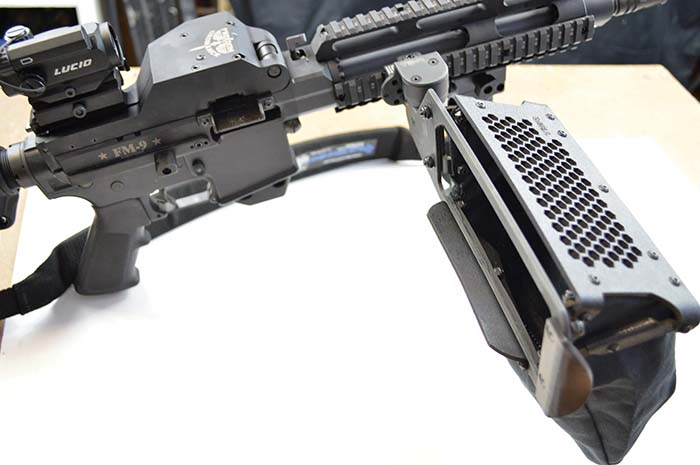
In conclusion, the FM-9 upper is one serious piece of equipment. I would not hesitate to recommend it to a police tactical unit or a VIP protection detail as it has shown outstanding reliability other than the first two hiccups when the unit was fired without any lube. That said, in subsequent tests after the upper was throughly cleaned it then ran fine without any lubrication whatsoever. Maybe two failures were even ammo related. Whatever it was, it never happened again in over 1000 rounds put through it.
By the way, the unit was not cleaned until after about the first 500 rounds were put through it. Even then the only thing done, was the top cover was opened up and the feed mechanism was swabbed out with some RamRodz swabs. Then the gun was put back into action. While I’m on the subject of cleaning, the unit is a pleasure to clean instead of a chore. The top cover and the feed block are held in place by a detent pin that can be easily pushed out with the tip of a cartridge. This allows the top cover and feed block to both be removed from the unit for cleaning. This coupled with a quick detach barrel and a bolt that is removed the same way a standard AR bolt is removed, makes the entire unit very easy and quick to clean. In fact, I merely dropped the parts in an ultrasonic cleaner for a few minutes and they were as clean as when they were new.
This author would be hard pressed to not recommend the FM-9 unit to anyone with an AR-15 or M-16 rifle. It is an accessory that is extremely well built, runs just as promised right out of the box and is reasonably priced. With an introductory retail price of just $1895.00 it is by far the most inexpensive way to own a belt-fed!
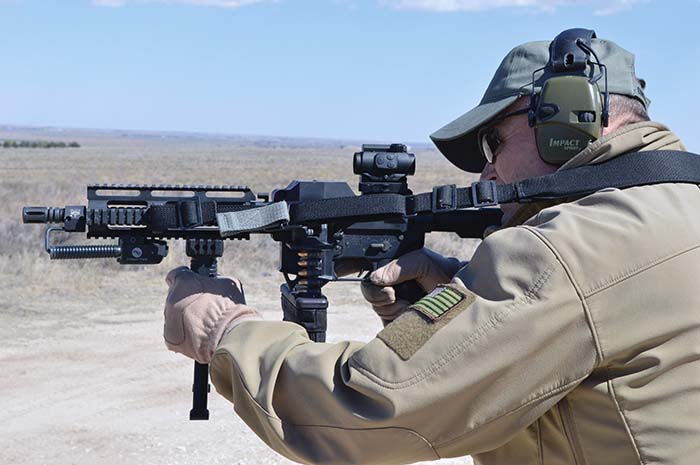
Freedom Ordnance
www.freedomordnance.com
Lucid
www.mylucid.com
Crimson Trace
www.crimsontrace.com
Blue Force Gear
www.blueforcegear.com
TriggerJockey
www.triggerjockey.com
Tactical Brass Recovery
www.tacticalbrassrecovery.com
| This article first appeared in Small Arms Review V20N8 (October 2016) |



